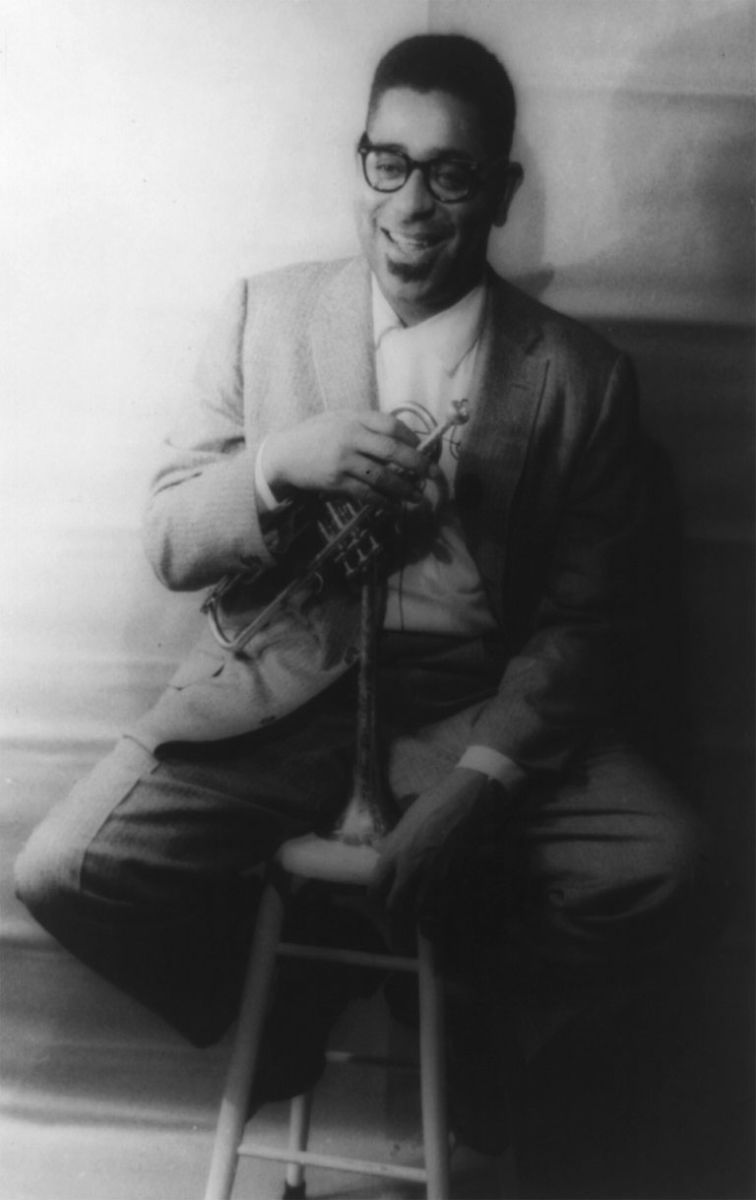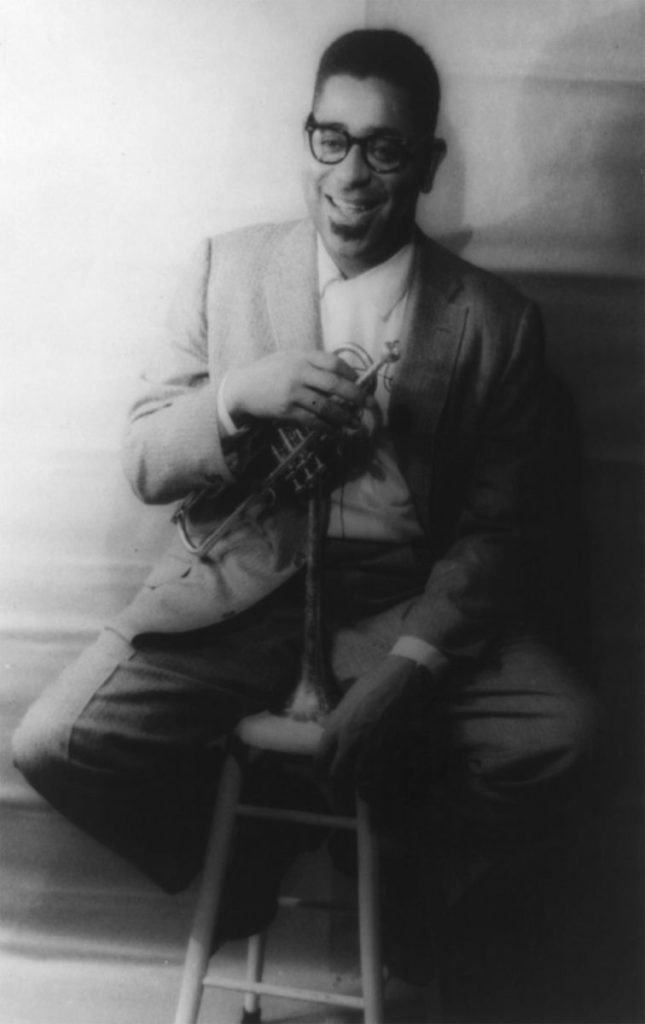
The biography by Alyn Shipton: Groovin’ High. The Life Of Dizzy Gillespie. OUP, 1999, 422 p. Get the paperback edition from Amazon.com, Amazon.co.uk. Sheet music by Dizzy Gillespie.
Alyn Shipton presents BBC jazz programs, is a jazz critic for The Times in London and has written biographies of Fats Waller and Bud Powell. In his book on Dizzy Gillespie (Groovin’ High. The Life Of Dizzy Gillespie. OUP, 1999, 422 p.), he digs deep, destroys some myths – Gillespie had a “tendency to economize with the truth when it was less favorable to him” – and reveals the dark secret of an illegitimate daughter of Dizzy, jazz singer Jeanie Bryson (*1958), the fruit of an affair with white songwriter Connie Bryson. Gillespie supported his only child financially, but even on his deathbed in 1993, refused to acknowledge her in public. Shipton also informs us about Dizzy’s love and sex life.
Having seen Dizzy Gillespie only towards the end of his life in the late 1980s in Geneva’s Victoria Hall as well as at the Montreux Jazz Festival, my impression of his capacities as a musician were – to put it politely – not very favourable. Shipton’s biography – together with Dizzy’s CDs – provided an occasion to discover the musician at his best.
Born in 1917 in the small South Carolina town of Cheraw, John Birks Gillespie was the son of a modest bricklayer who played the piano on Saturdays with the local band. He died when Dizzy was ten and still not interested in music. The young Gillespie got his musical education from neighbours and at school, especially after the arrival of a collection of instrument donated by the state in 1929. After the piano, he soon chose the trumpet, but never received any formal training. Dizzy taught himself by trial-and-error and with the help of friends. He also played in the school band. Later, he moved to Laurinburg. Jazz in the South was still traditional and not influenced by the developments in Chicago and New York.

Dizzy Gillespie in 1955. Photographed by Carl Van Vechten (1880-1964). Wikimedia Commons, public domain.
Gillespie dropped out of junior high school during the Depression in order to support the family and worked like so many in the cotton fields (on WPA projects). In 1935, he moved to Philadelphia rejoining his mother. He got a job with the Frankie Fairfax band that, within a few days of his arrival, conferred Gillespie’s nickname on him”. The drummer, Norman Dibble, asked “Where’s Dizzy?” The name stuck. Dizzy remained with the group until the spring of 1937. In 1936, the trumpeters Charlie Shavers and Carl “Bama” Warwick had joined the band. For the first time, Gillespie had the chance to discuss technique and experiment with trumpeters (of his age). He learned to imitate Louis Armstrong (and still not yet Roy Eldridge). – Gillespie told a lot of stories about his life and musical education that cannot be true. For instance, Shipton found out that it had been impossible for Gillespie to have listened to Roy Eldridge on the radio in Cheraw as a boy since Eldridge had not been broadcasted during those years. In Shipton’s opinion, Gillespie had been influenced in the beginning by Louis Armstrong – Gillespie probably denied it because of Satch’s manifest antipathy towards Bepop – by swing star Charlie Shavers and by Henry (Red) Allen.
In May 1937, he recorded his first record. He moved to New York to rejoin Shavers and Warwick in the Mills Blue Rhythm Orchestra headed by Lucky Milinder. But the job never opened up for him. Instead, he managed to play from time to time with famous bands like the Savoy Sultans and Chick Webb’s Orchestra (where he met Mario Bauza who later introduced him to the concept of Afro-Cuban music). Still in 1937, he was able to be part of Teddy Hill’s band and its European tour. Rehearsing on the boat to the old continent, it became clear that “Dizzy’s experience with Frankie Fairfax was not adequate for him to play with the control that Hill’s men took for granted.” Gillespie was excluded from a recording session in Paris. His popularity also suffered from his money-lending scheme. “The older guys borrowed from him and had to pay him back with usurous interest.” A band member confessed: “The dislike was real enough and long-lasting.”
In January 1938, Dizzy got the permission to work in New York again. There he met again a dancer he had first seen in late 1937 on a brief visit to Washington with Edgar Hayes: Gussie Lorraine Willis. She became his regular girlfriend, helped him financially while he waited for his transfer to be accepted and – some years later – became his wife.
In summer 1939, Dizzy joined Cab Calloway’s band, one of the commercially most successful. The two years he spent with him “put Dizzy on the map as a trumpet soloist” (August 1939 – September 1941). Playing with Calloway, he found the time to play after-hours with other players. Historians date this experiments at Minton’s to 1940. Based on the study of the date sheets of Calloway’s band, Shipton concludes that the after-hours sessions took place in 1939. Not at Minton’s with its reputation as birthplace of bebop, but at Clark Monroe’s Uptown House. It is also there that Dizzy was recorded creating “a fledgling bebop solo on a piece called ‘Kerouac’, in May 1941.”
Together with Charlie Parker (sax), Bud Powell (p) and Kenny Clarke (dr), Gillespie was part of the 1940’s jazz revolution known as bebop. Dizzy had first worked with Clarke in 1937. This drummer was known for his unorthodox “klook-a-mop” style. A name used for a short time to describe what became bebop. It was the avantgarde-style until 1959 [added on April 29, 2002: okay, maybe only until 1948 when Miles Davis founded the nonet “Birth of the Cool” which invented Cool Jazz which, according to Leonard Feather, is “the less aggressive and hard-edged style of bebop”] when another revolution – free jazz by Miles Davies, John Coltrane and Ornette Coleman – hit the jazz circuit. Bebop was a revolution not only on the musical level, but also because it was no dancing music. Jazz became a listening thing, probably one of the main reasons why jazz slipped out of the mainstream. Dizzy’s part in the creation of bebop is still underestimated. Parker and his fellow members of the Jay McShann orchestra get most of the credit. But according to Shipton, it was Gillespie who “organized the principal ideas of the beboppers into an intellectual framework [that allowed bebop to] progresss beyond a small and restricted circle of after-hours enthusiasts”.
Shipton explains in detail the creation, essence and evolution of bebop (the biggest part of the book). He presents the key figures like Charlie Parker and their relation with Dizzy. He also notes that bebop in its pure form only lasted a few years. Dizzy himself removed “most of the rhythmic and harmonic aspects of bebop that where hardest for uninitiated listeners to understand or appreciate.” It was that light-version of bebop that made him popular. Besides that, Gillespie also developed Afro-Cuban jazz and produced later with composer and pianist Lalo Schifrin some major works for the concert hall and was part of the – not always so tasteful – bossanova craze (English lyrics do not match with bossanova, a music created for Brazilian-Portugues).
Nothing really important seems to have happened in Dizzy’s musical career after the 1950s. Therefore, that part of Shipton’s book is not so fascinating. Groovin’ High is a valuable account – with notes, bibliography and index – of the life of one of the best ambassadors of jazz. Besides that, Shipton portrays all the important figures Dizzy met: Teddy Hill, Cab Calloway, Charlie Parker, Thelonious Monk and all the others. Sheet music by Dizzy Gillespie.
Review, moved here (from English edition no. 2 February 1999) on July 20, 2005:
An Electrifying Evening With The Dizzy Gillespie Quintet (Verve/Universal)
In Verve’s Master Edition series you can get the masterful 1961-album An Electrifying Evening With the Dizzy Gillespie Quintet. Recorded at the Museum of Modern Art, New York City, the four tracks are Kush (written by Gillespie), Salt Peanuts (Gillespie and Kenny Clarke), A Night in Tunisia (Gillespie and Frank Paparelli) and The Mooche (Duke Ellington). The musicians are : Dizzy Gillespie (trumpet), Leo Wright (alto saxophone, flute), Lalo Schifrin (piano), Bob Cunningham (bass) and Chuck Lampkin (drums). Recorded in 1961, the album shows Gillespie and his Quintet at their best. In comparison with the Oscar Peterson-album Very Tall, it is avantgarde. Peterson’s album represents the musical universe of the 1950s. A world at peace with itself, happy, optimistic and entertaining. The Gillespie Quintet presents less harmonious tunes and a world less balanced. After the demise of the State Department big band in 1958, Gillespie was back in the familiar configuration of the classic bebop quintet. The CD includes an 18-minute interview with Dizzy Gillespie by Charles Schwartz.
The biography by Alyn Shipton: Groovin’ High. The Life Of Dizzy Gillespie. OUP, 1999, 422 p. Get the paperback edition from Amazon.com, Amazon.co.uk. Sheet music by Dizzy Gillespie.